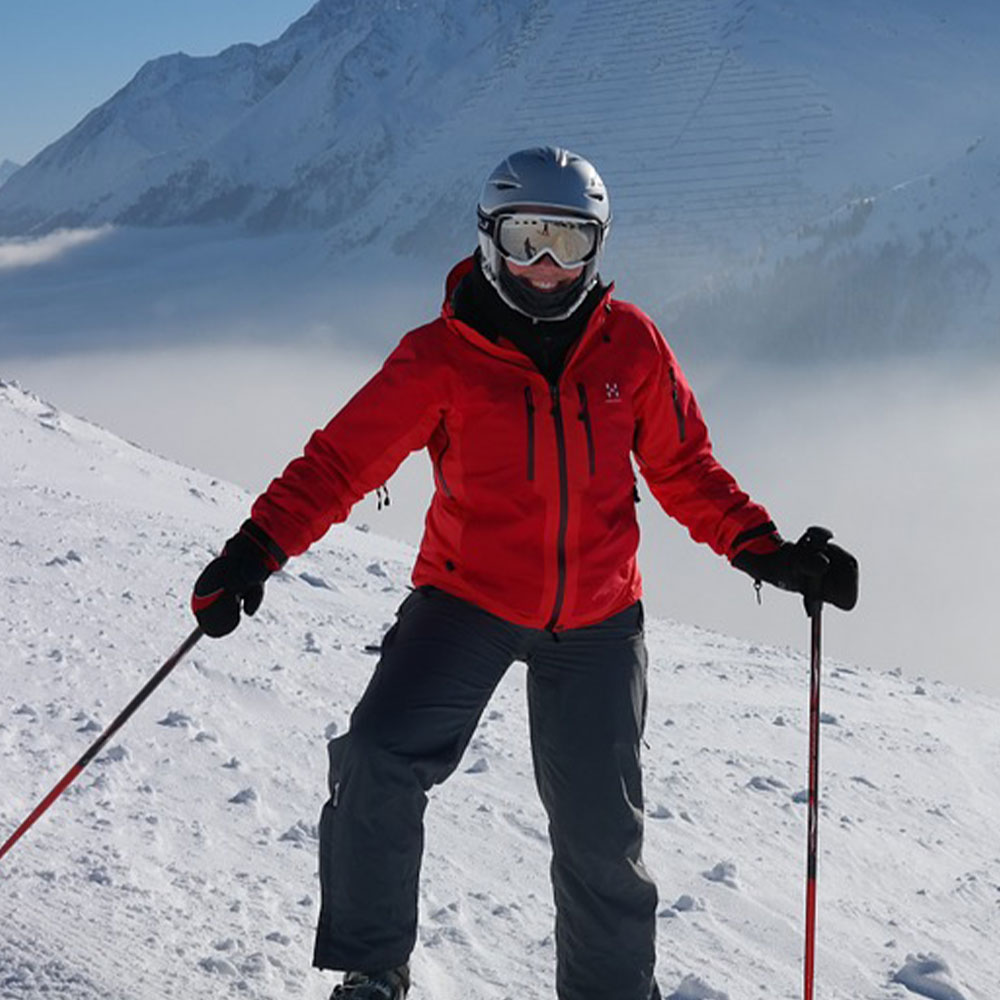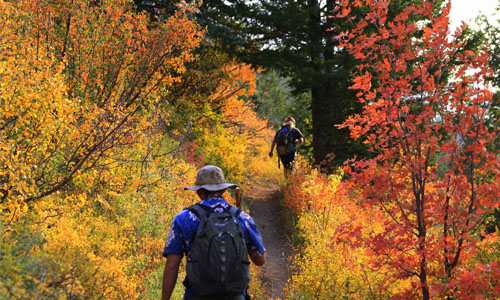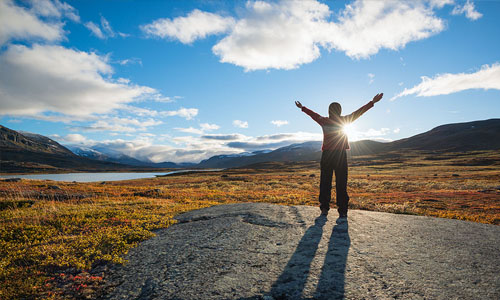How to Go Backpacking in the Colder Months
Author

A keen runner, skier and nuts about cycling. Karl lives in Cumbria, where he loves encouraging his two children to follow in his outdoor lifestyle. Whilst out and about keeping active, Karl keeps a diary and shares it with Outdoor Look.
 Autumn and winter get a bad rap, as people see them as the chilly, hostile months when it's best to stay indoors wrapped up under a blanket with a warm cup of tea. I beg to differ. As I sit indoors sipping on my cuppa, I stare longingly out of the windows and imagine the adventures that I could be having in the great outdoors, free from the searing threat of heat exhaustion, which plagues me in the summer months. I think the problem is that many people simply go about backpacking in the colder months of the year incorrectly, so here are a few tips of mine which have helped me to have some thoroughly enjoyable hiking experiences in the autumn.
Autumn and winter get a bad rap, as people see them as the chilly, hostile months when it's best to stay indoors wrapped up under a blanket with a warm cup of tea. I beg to differ. As I sit indoors sipping on my cuppa, I stare longingly out of the windows and imagine the adventures that I could be having in the great outdoors, free from the searing threat of heat exhaustion, which plagues me in the summer months. I think the problem is that many people simply go about backpacking in the colder months of the year incorrectly, so here are a few tips of mine which have helped me to have some thoroughly enjoyable hiking experiences in the autumn.
Keeping Warm in the Tent
Ideally, you want a tent that is not only lightweight, but that also offers you the crucial all-weather protection that you really need in autumn and winter. Depending on where you're camping, wind can be an issue at any time of the year, but it certainly tends to pick up in the colder months. Make sure you've got a good set of tent stakes to keep your tent in place no matter how hard the gales blow!
As you need to prevent the cold ground from sucking up your body heat, you'll also need a comfy sleeping pad that is made using a lightweight fabric and is heavily insulated. Being too cold to sleep can really ruin the whole camping trip, so make sure you get this right!
Equipment and Accessories
To add extra warmth to your sleeping bag, you can use a hard-sided bottle that is filled with hot water. Just make sure it's screwed tightly so that you can place it in your bag. Regarding food, you should be prepared for longer cooking times when the weather turns cold. You may also need extra fuel for heating water and lighting bonfires apart from cooking. I always carry extra fuel, as purchasing it from a distant location during camping can be expensive.
Make sure you have a good headlamp, as the sun can set earlier than you expect and leave you scrambling around in the darkness. Bring spare batteries if your headlamp takes them.
Emergencies
You should always carry maps and compass during trips to explore new locations. Carrying an altimeter and keeping GPS guidance handy is also a good idea. A well-organized first aid kit is indispensable as the harsh weather conditions may create some health concerns.
 Food Items
Food Items
Meals should be kept simple during these trips, so opt for pre-packaged boil-and-go options. You can also pack appetizers, desserts, hot beverages and food rich in carbs & fats to keep yourself energized. Carrying adequate water is very essential as water sources may dry up towards the end of the summer season.
Apparel
I always prefer wearing bright clothes for high visibility, and also ensure that my clothes are quick-drying. As you cannot predict the weather, wearing gaiters to keep my feet dry always works for me. Socks should be chosen according to breathable comfort and moisture-wicking ability. Packing innerwear thoughtfully is extremely essential and you should do it in accordance with the temperature of the place you are heading to. Carrying hats, gloves and similar clothing accessories is always advisable. You should also keep sunscreens and other toiletries handy, just in case. Packing a rain jacket is important to safeguard yourself from sudden rains and to add an extra layer of warmth to your outfit when the temperature goes down.
Packing for outdoor adventure trips is tough, but if you plan it well then you will enjoy heading out for such trips time and again. The only thing I keep in my mind while travelling is that whatever I need to survive should be with me, as looking out for basic essentials is troublesome in such scenarios. The places to visit during these trips should be planned in advance so that you can enjoy your trip to the fullest and save yourself from last minute glitches.
Author

A keen runner, skier and nuts about cycling. Karl lives in Cumbria, where he loves encouraging his two children to follow in his outdoor lifestyle. Whilst out and about keeping active, Karl keeps a diary and shares it with Outdoor Look.
Categories
- Sport (28)
- Product Reviews (3)
- Team Outdoor Look (7)
- Mike Wild (2)
- Mike Payton (2)
- Suse Hammond-Pears (3)
- Snowboarding (12)
- Latest Offers (105)
- Shop Talk (1)
- Competitions (7)
- Walking (413)
- Lifestyle Fashion (8)
- Travel (86)
- Kit Guides (176)
- Workwear Clothing (6)
- Safety Workwear (4)
- Health/Fitness (289)
- Skiing (91)
- Great Outdoors (1316)
- Cycling (92)
- January 2025
- December 2024
- November 2024
- October 2024
- September 2024
- August 2024
- July 2024
- June 2024
- May 2024
- April 2024
- March 2024
- February 2024
- January 2024
- December 2023
- November 2023
- October 2023
- September 2023
- August 2023
- July 2023
- June 2023
- May 2023
- April 2023
- March 2023
- February 2023
- January 2023
- December 2022
- November 2022
- October 2022
- September 2022
- August 2022
- July 2022
- June 2022
- May 2022
- April 2022
- March 2022
- February 2022
- January 2022
- December 2021
- November 2021
- October 2021
- September 2021
- August 2021
- July 2021
- June 2021
- May 2021
- April 2021
- March 2021
- February 2021
- January 2021
- December 2020
- November 2020
- October 2020
- September 2020
- August 2020
- July 2020
- June 2020
- May 2020
- April 2020
- March 2020
- February 2020
- January 2020
- December 2019
- November 2019
- October 2019
- September 2019
- August 2019
- July 2019
- June 2019
- May 2019
- April 2019
- March 2019
- February 2019
- January 2019
- December 2018
- November 2018
- October 2018
- September 2018
- August 2018
- July 2018
- June 2018
- May 2018
- April 2018
- March 2018
- February 2018
- January 2018
- December 2017
- November 2017
- October 2017
- September 2017
- August 2017
- July 2017
- June 2017
- May 2017
- April 2017
- March 2017
- February 2017
- January 2017
- December 2016
- November 2016
- October 2016
- September 2016
- August 2016
- July 2016
- June 2016
- May 2016
- April 2016
- March 2016
- February 2016
- January 2016
- December 2015
- November 2015
- October 2015
- September 2015
- August 2015
- July 2015
- June 2015
- May 2015
- April 2015
- March 2015
- February 2015
- January 2015
- December 2014
- November 2014
- October 2014
- September 2014
- August 2014
- July 2014
- June 2014
- May 2014
- April 2014
- March 2014
- February 2014
- January 2014
- December 2013
- November 2013
- October 2013
- September 2013
- August 2013
- July 2013
- June 2013
- May 2013
- April 2013
- March 2013
- February 2013
- January 2013
- December 2012
- November 2012
- October 2012
- September 2012
- August 2012
- July 2012
- June 2012
- May 2012
- April 2012
- March 2012
- February 2012
- January 2012
- December 2011
- November 2011
- October 2011
- September 2011
- August 2011
- May 2010
- April 2010
- March 2010
- February 2010
- January 2010
- November 2009
- October 2009
- September 2009
Submit a Comment